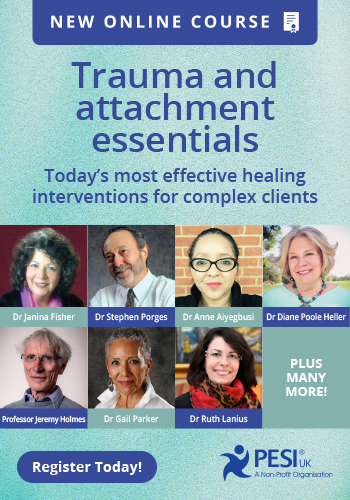Dr Diane Poole Heller | {1121855_Diane_HellerWithBio}
Restoring Embodiment, Empowerment, and Safety: Healing Power Wounds underlying Victim-Perpetrator Dynamics and Disorganized Attachment
Learn creative and practical ways to assess and address power dynamics by learning about the residual interpersonal effects of living in a chronic threat response due to unresolved victim-perpetrator dynamics, dissociation and fragmentation alternating with emotional or physiological flooding, and disorganised Attachment.
Michael Soth |
Common enactment issues in supervision
The modern - and especially somatic - trauma therapies, aided by revolutionary neuroscientific understandings, have made a profound contribution to the field over the last 20 years. Increasingly, trauma therapists come into supervision distraught, frustrated and despirited because it is not working as it ‘should’. The assumption that the same trauma theories and techniques can equally well be applied to developmental trauma is now becoming questionable. As soon as developmental trauma is involved, what really matters is the client's implicit and unconscious experience of the therapeutic relationship, regardless of the therapist's competence and input. The relational complications and vicissitudes that arise between client and therapist used to be the province of psychoanalysis and depth psychotherapy, but they can now be seen to be relevant to trauma work, too.
Dr Anne Aiyegbusi |
Inter-relational complexities of trauma in groups, teams and institutions
Complex trauma dynamics reverberate through all levels of the treatment setting. This presentation will focus on inter-relational complexities of trauma in groups, teams and institutions. By the end of the module, you will have an awareness of:
- Group analytic perspective on trauma
- How trauma phenomena impacts treatment settings
- Strategies to mitigate secondary trauma on teams
Kathy Steele, MN, CS |
The key to using countertransference to resolve relational enactments
When the client is highly dissociative, the therapist is vulnerable to intense and sometimes overwhelming emotional experiences that are often projections of fragmented parts of the client, or non-verbal enactments of unintegrated trauma. We will discuss these emotions that range from positive to negative, and how to understand and use them therapeutically. You will walk away being able to:
- Identify at least three emotional reactions to their clients and how they relate to the dynamics of the clients.
- Define enactment and give an example from clinical practice.
- Describe strategies to manage countertransference feelings and use them to support an effective therapy with dissociative clients.
Dr Ruth Lanius |
Altered States of Consciousness and Dissociation: Toward the Restoration of the Self
Psychological trauma and childhood attachment disruptions are often associated with emotion dysregulation, altered states of consciousness, dissociation, and a perceived loss of one’s sense of self. This lecture will examine the neuroscience, and the related brain/mind/body correlations, underlying five dimensions of consciousness: time, thought, body, emotion, and intersubjectivity. The restoration of the self through the integrated experience of these five dimensions of consciousness in the aftermath of trauma will be described. Clinical case examples involving the use of mind/brain/body techniques will be utilized to illustrate relevant concepts.
Dr Pat Ogden |
Drawing on the Body to Integrate Conflicting Attachment Patterns in Dissociative Clients
For dissociative clients, internal parts of the self often experience contradictory relational goals and attachment tendencies. In times of stress, these conflicting goals and tendencies can become more entrenched, exacerbating dissociative symptoms, increasing dysregulation and wreaking havoc on relationships. In this presentation, we will explore the effects and somatic components of contradictory internal attachment tendencies. Interventions from Sensorimotor Psychotherapy to work with the body to facilitate integration of internal attachment tendencies, and better cope with stress, will be introduced.
Dr Janina Fisher |
Trauma & Attachment: interpersonal neurobiology and the traumatic transference
Watch world renowned trauma and attachment expert Janina Fisher, PhD as we discuss the latest methods for working with attachment. You’ll learn:
- How attachment history shows up in the ‘here’ and ‘now’
- Understand the ‘dyadic dance’ and interpersonal neurobiological regulation
- Traumatic attachment, transference and counter transference
- Changing traumatic patterns in relationships - how and why corrective experiences are necessary for lasting change
- And so much more!
Professor Stephen Porges |
Understanding the impact of stress and adversity on social connectedness: A Polyvagal Perspective
The Polyvagal Theory explains how social behaviour turns off defences and promotes opportunities to feel safe. It provides an innovative model to understand bodily responses to trauma and stress and the importance of the client’s physiological state in mediating the effectiveness of clinical treatments. From a Polyvagal perspective, interventions that target the capacity to feel safe and use social behaviour to regulate physiological state can be effective in treating psychological disorders that are dependent on defence systems.
Michael Soth |
Treating trauma – essentials for working with relational complications
Watch international trainer and esteemed psychotherapist Michael Soth for an innovative discussion on the complexities of working with trauma. You’ll learn:
- How trauma affects internal attachment and the internal family system
- The self-care system and working alliances with different parts in the internal family system
- The internalisation of the ‘wounding object’ in developmental trauma
- How the ‘wounding enters’ the consulting room and the client’s conflict becomes the therapist’s conflict
- Essential information for working with relational complications
- And so much more!
- For more detailed information: .












